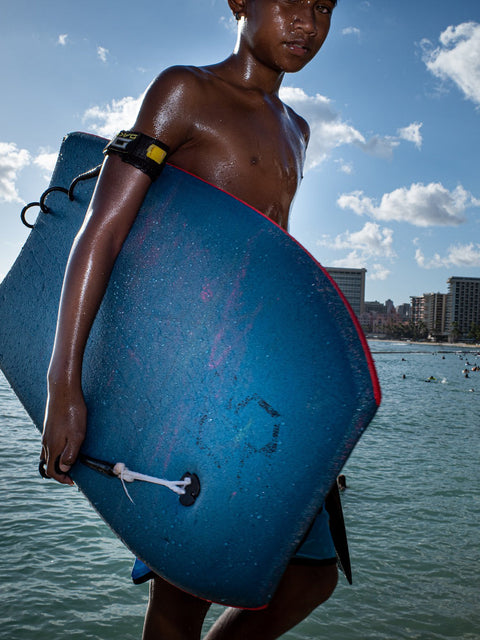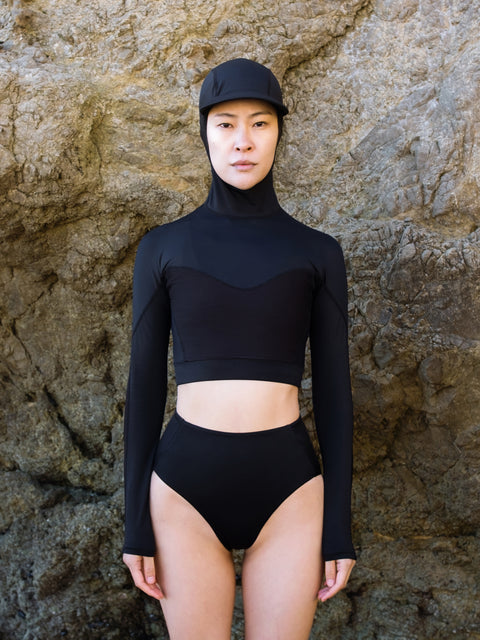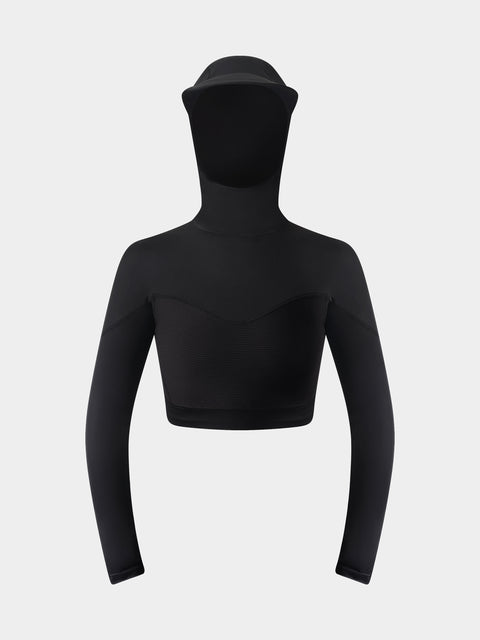
Raw Exposure: Tim Huynh gives us the word on the street
Tim Huynh’s photography is a celebration of life’s raw, unfiltered moments.
Born and raised on Oahu, his work captures the dynamic interplay of local culture and tourism in Hawaii, the fleeting moments on the bustling beaches of Waikiki, and the candid, often quirky details that go unnoticed in everyday life.
 We are honored to collaborate with Tim this May for Skin Cancer Awareness Month, using his powerful imagery to emphasize the very real dangers of UV exposure and the critical need for responsible sun care—a theme that deeply resonates with our mission of promoting sun protection and skin health within the surfing community.
We are honored to collaborate with Tim this May for Skin Cancer Awareness Month, using his powerful imagery to emphasize the very real dangers of UV exposure and the critical need for responsible sun care—a theme that deeply resonates with our mission of promoting sun protection and skin health within the surfing community.
In this interview, Tim Huynh reflects on his journey into street photography, the quirks of Waikiki beach life, and how his work brings sun safety into sharp focus
VSC: What first made you interested in street photography, and how has your style evolved since you started? Were there any pivotal moments that shaped your development as an artist?
TH: In 2010, I was in Chicago interning at a small production studio and one of the fellow interns was telling me about Vivian Maier. He showed me her website and told me the whole back story on how his friend John Maloof bought these negatives from an auction and started scanning them and uploading the images on the internet.
Her images had inspired me, it was so raw and full of life. I thought to myself, if I’m in Chicago where many of these images were produced, I can do that too. I started walking around Rogers Park and Michigan Avenue just snapping away. What resulted was a bunch of out of focus images, mainly of the homeless. Already I had a greater appreciation for Vivian Maier and what she was able to capture. From that week of shooting I had a greater appreciation for her photographs and what she was able to capture. She made it look so simple and easy, but of course it wasn’t.
I think one way my work has evolved is I now put more of an emphasis on finding the light. Before I had worked a 9-5 job, so my shoot availability was really based around that, during lunch with harsh lighting and weekends. Now I have full autonomy of my time, therefore I usually aim to shoot during late afternoons 3pm - 6pm for that golden light.
VSC: Being born and raised in Honolulu, how has the unique blend of local culture and tourism in Hawaii influenced your photographic perspective? Are there specific aspects of Hawaiian life that you aim to capture in your work?
TH: At first glance, my photography might seem focused on sunburns and the quirks of everyday street life. However, my true interest lies in capturing the contrast between how tourists experience Hawaii as a vacation destination and how locals experience it as home.
 VSC: Your Beach Please! series captures candid moments on Hawaiian beaches. What inspired this project, and what narratives are you aiming to convey through these images?
VSC: Your Beach Please! series captures candid moments on Hawaiian beaches. What inspired this project, and what narratives are you aiming to convey through these images?
TH: Shooting predominantly in Waikiki, I’m constantly surrounded by beach culture and the quirks of life both on the sand and along the sidewalks.
"One thing that caught my attention was how sunburnt many visitors were—and, through small talk, I learned they took great pride in it. Despite the sheer number of sunburnt beachgoers, finding one truly worth photographing is surprisingly rare."
One thing that caught my attention was how sunburnt many visitors were—and, through small talk, I learned they took great pride in it. Many were from the Midwest, experiencing a real beach for the first time, and for them, a sunburn was almost like a badge of honor to bring home.
When it comes to photographing sunburns, I’m quite particular. They have to be either extremely severe or create a uniquely interesting pattern on the body. Despite the sheer number of sunburnt beachgoers, finding one truly worth photographing is surprisingly rare.

 VSC: What are some of the challenges you’ve faced while photographing in Hawaii, especially in bustling areas like Waikiki, and how have these experiences shaped your approach to street photography?
VSC: What are some of the challenges you’ve faced while photographing in Hawaii, especially in bustling areas like Waikiki, and how have these experiences shaped your approach to street photography?
TH: A constant challenge I face is feeling 'Waikiki-ed out.' After shooting in the same area for over a decade, it’s easy for things to start feeling repetitive. But all it takes is one great shot—one moment that excites me—and everything shifts. That’s the beauty of street photography, you can return to the same corner at the same time every day, yet no two photos will ever be the same. The light changes, the people change—there’s always something new waiting to be captured.
"I'm always drawn to the strange, the eccentric, the misfits"
VSC: Hawaii has such a deep-rooted surf culture—do you surf or have you ever tried surfing yourself?
TH: Surprising or not, I’ve never been much of a water person. Growing up, my friends and I would hang out at Waikiki Walls simply because we had nothing better to do. While they were naturals in the ocean, effortlessly bodyboarding and even competing in contests, I was mostly just along for the ride.

 VSC: Your work often captures striking moments in everyday life. What draws you to certain scenes, and how do you decide what stories to tell through your lens?
VSC: Your work often captures striking moments in everyday life. What draws you to certain scenes, and how do you decide what stories to tell through your lens?
TH: I'm always drawn to the strange, the eccentric, the misfits—probably because that's how I see myself. But it’s not always about a person; sometimes, it’s just a gesture, what they have on or a moment that carries that same energy. If something speaks to me instinctively, I know I need to capture it immediately. I don’t always know at the moment whether it will make a great photograph, but I believe in shooting first and figuring it out later.
That said, every photographer should have some kind of mental or instinctual intention behind each shot. Don’t press the shutter just for the sake of it—shoot what truly speaks to you.
VSC: What do you hope people take away from your work, especially when it’s used to highlight important causes like Skin Cancer Awareness?
TH: For my sunburn series, I want people to recognize the real consequences of not wearing sunscreen. No matter your skin tone, the sun’s UV rays affect us all.
It wasn’t until 2023 that I started applying sunscreen when going out to shoot. Before that, I was more focused on getting a nice tan and didn’t fully understand the risks of sun damage and premature aging. I have to credit YouTuber Hyram Yarbro, whose skincare content has been incredibly eye-opening—especially since I edit his videos.

 VSC: You have also directed Fill the Frame, a documentary about New York City street photographers. What inspired you to tell their stories on film, and how did your own experiences as a photographer shape the way you approached the project?
VSC: You have also directed Fill the Frame, a documentary about New York City street photographers. What inspired you to tell their stories on film, and how did your own experiences as a photographer shape the way you approached the project?
TH: I was very determined to make a full-length documentary. Usually in documentary film, you need to have some sort of connection with the subject matter. As my interest in street photography continued to grow, I realized this was it! There weren't many other films out there (other than the most notable “Everybody Street”), yet there are so many people around the world that pursue this form of photography.
I let the idea brew for a couple years, just to ensure that I would still feel passionate about it. After a while I decided instead of daydreaming about this documentary, I needed to put my ideas into action. My original idea was to highlight a street photographer in different parts of the world but knew realistically that would not be possible with a limited budget. So I just narrowed it down to New York City. The location has such a rich history and contained a mix of seasoned and new street shooters. I then contacted photographers that I was already following on Instagram and sent them a questionnaire asking them to detail a little more about their own personal back story. Many didn’t respond to my emails, others I did not find too interesting, and few did not want to be involved. Can you blame them? They must have been thinking who’s this kid from Hawaii doing a documentary on New York City street photographers.
I’m very happy with the eight photographers casted in the film. All are excellent photographers with amazing backstories. To me these backstories help bring their photography to life. Taking nice pictures isn't enough, there was more of the story to unveil for these photographers. So I was up for the challenge.
The film is now free on my youtube channel - Check it out here
Tim’s work challenges us to see the everyday in a new light, capturing simple yet powerful moments that make life unique. With his candid approach and keen eye for detail, his “Beach Please!” series offers a stark reminder of the consequences of sun damage—a visual call to action to protect your skin.
Explore more of Tim’s incredible photos on his website and watch his documentary Fill the Frame on his YouTube channel, WORDONTHESTREET. Let Tim’s work inspire you, just as it has inspired us, and take a moment to reflect on how the ordinary can be extraordinary through the right lens.







